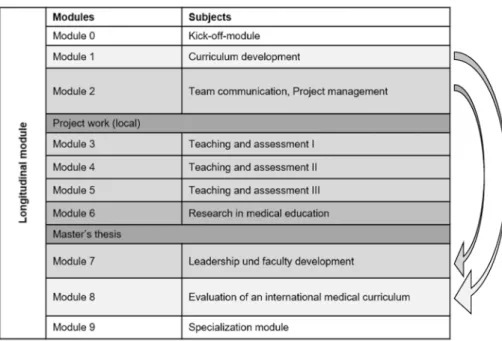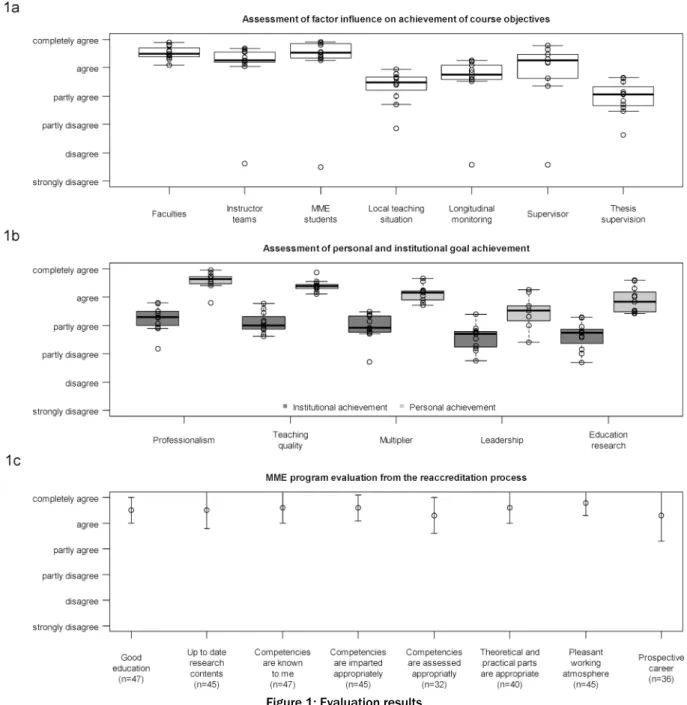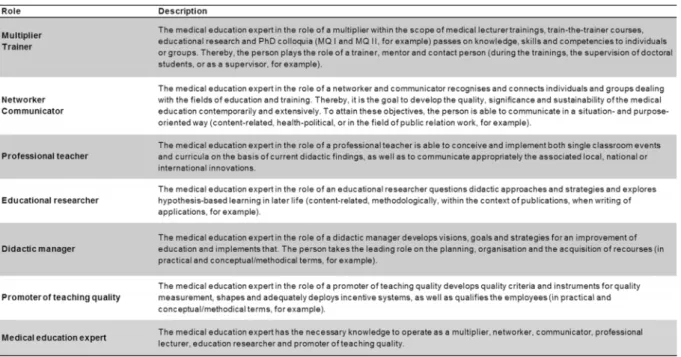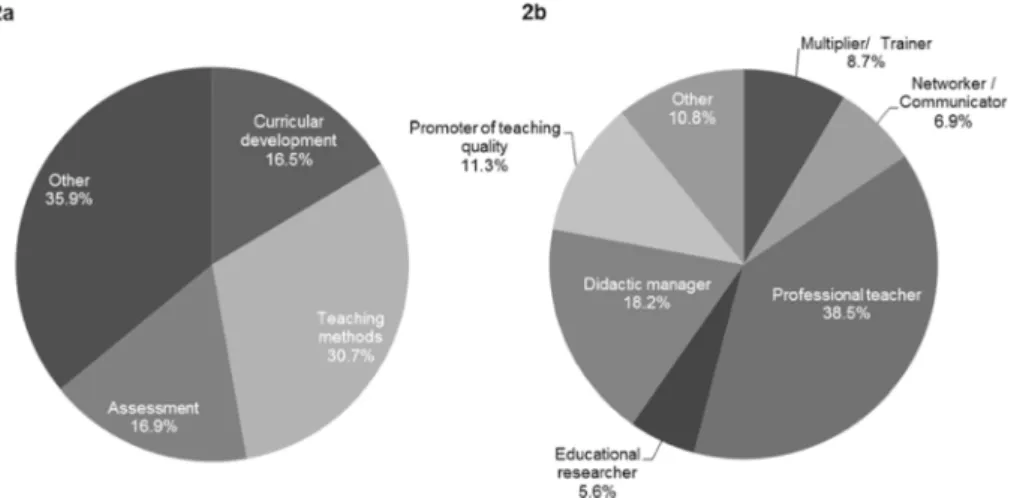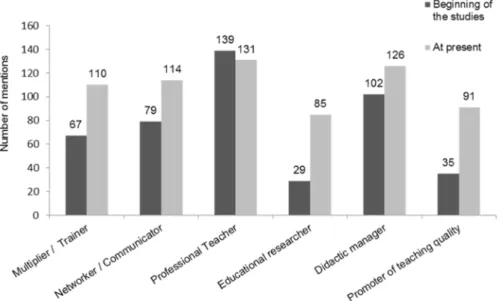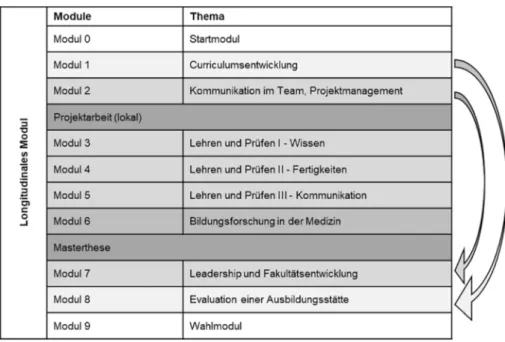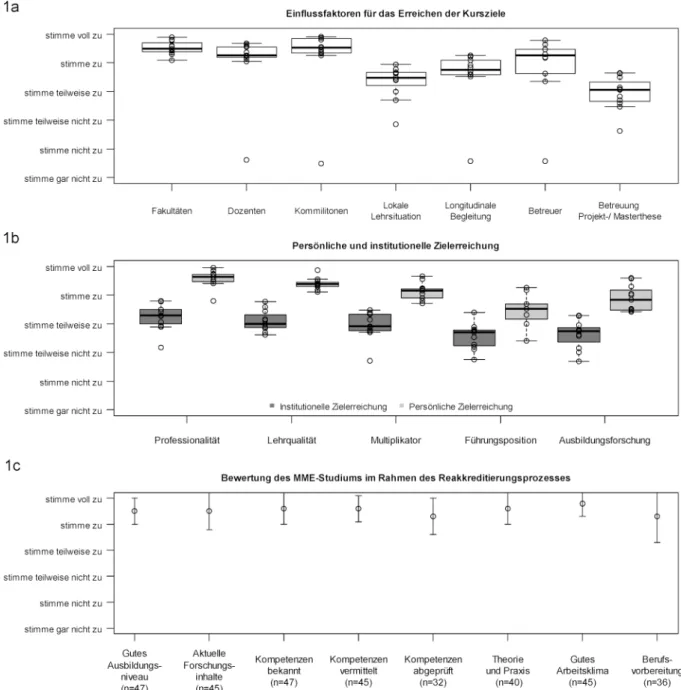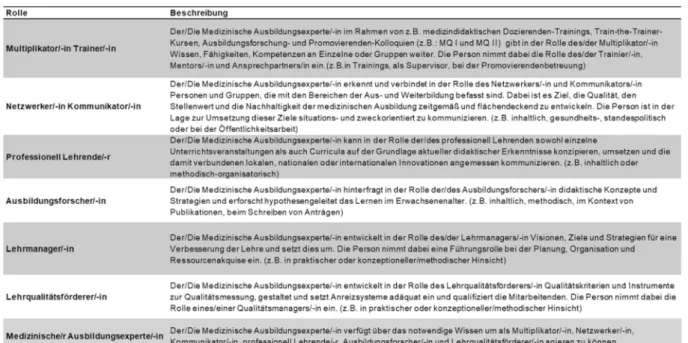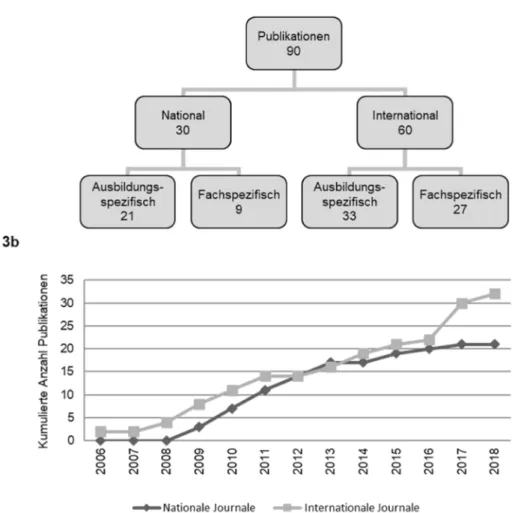Do it together! Conception and long-term results of the trans-institutional Master of Medical Education (MME) program in Germany
Abstract
Medical education has the responsibility to react to developments and changing demands in healthcare. This implies the need for experts in
Jana Jünger
1,2Saskia V. Pante
1the area of medical education as well as nationally coordinated initiat-
Kristina Ackel-Eisnach
3ives. An innovative model based on trans-institutional cooperation and
Stefan Wagener
1nationwide consensus for establishing a master’s degree course in Medical Education (MME) and long-term results are presented here to
Martin R. Fischer
4other countries and other programs, facing similar challenges. A MME program with the following goals was implemented at the Medical Faculty
of Heidelberg University, Germany, in 2004: 1 Heidelberg University,
Medical Faculty of 1. Qualification of leaders in medical faculties, Heidelberg, MME program,
Heidelberg, Germany 2. professionalization and improvement of teaching quality,
3. promotion of nationwide and international exchange, and
2 Institute of Medical and Pharmaceutical Proficiency Assessment, Mainz, Germany 4. stimulation of research in medical education.
Since then, 15 cohorts with a total of 380 participants have started
their studies, 179 participants have graduated and 90 publications 3 University of
Koblenz/Landau, Empirical resulted from the master’s theses (as at November 2018). Evaluation
and survey data revealed a very high degree of satisfaction among the Pedagogical Research, Landau, Germany participants and a lasting development to medical education experts.
Our concept shows that the bundling of regional expertise into a clearly 4 University Hospital, LMU Munich, Institute for Medical Education, Munich, Germany structured trans-institutional network can be a driving force for nation-
wide comprehensive changes, in order to address changing demands in healthcare systems and transfer it into medical education programs.
Keywords:Master program, medical education, model character, postgraduate, interfaculty, train-the-trainer, evaluation
Background
In order to meet the various tasks and requirements of the medical profession, a continuous further development of the medical education including changing demands in healthcare is essential [1]. Over the past two decades the need for medical experts who develop new curricula and teaching methods and transfer findings from educa- tional research to medical education has grown signific- antly [2], [3], [4]. At the same time, the number of quali- fication programs for teaching staff, especially those which are locally based, has been rising globally since 1990 [5], [6], [7], [8]. A report on master’s degrees in medical education identified a rise from 15 to 21 pro- grams in the English-speaking world in 1998 [3], [9] to 76 in 2012 [10] and to 121 in 2013 [11]. Supporting this positive trend, presently, the Faimer Institute lists a number of 132 worldwide master’s Programs in Health Professions Education [https://www.faimer.org/
resources/mastersmeded.html].
In a systematic review of available master’s programs in health professions/medical education worldwide Tekian
and Harris recently showed that there was a geographic maldistribution of such programs [10]. The US (15 pro- grams) and the UK (20 programs) are clearly ahead with the largest number of programs. This reflects the long tradition of medical research in education as well as ex- perience in the area of faculty development in the US and in the UK [12], [13], [14].
A major milestone for significant change in medical edu- cation in the US was the Flexner Report that revealed in- adequate conditions in medical schools throughout the United States [15]. In Germany, after a devastating ex- odus and loss of academic excellence and culture due to the totalitarian Nazi regime and World War II, there have been few changes and reform efforts in medical education in post war West Germany. It was only in the 1990s that a broad reflection on the view of physicians and the necessary changes in medical education took place, which finally led to a new Legal Framework for Regulating Licenses to Practice Medicine (Ärztliche Ap- probationsordnung) in 2003 [https://www.gesetze-im- internet.de/_appro_2002/BJNR240500002.html]. It calls for stronger practical relevance in university studies,
However, there was a risk of putting a lot of effort into developing new, localized and disconnected solutions for general problems. Thus, Germany had to choose between importing extensive expertise from the outside or creating national structures and networks through the use and further development of regional expertise. To our know- ledge, there is no model for a nationwide MME program world-wide so far, which addresses the national chal- lenges and the specific regional needs embedded in an international perspective. Hence, this publication provides data about conception and long-term results of the Ger- man MME program as an example for such a national initiative.
Program development
Following an initiative of the German Association of Medical Faculties (“Medizinischer Fakultätentag” (MFT)), an interdisciplinary model was developed which serves as a nationwide qualification program for teaching staff in medicine and regionally expertise becomes available for all faculties [17], [18]. An interfaculty committee de- veloped a basic concept for the course Master of Medical Education (MME) with the following goals:
1. qualification of leaders in medical faculties, 2. improvement of teaching quality,
3. promotion of nationwide and international exchange and
4. fostering of research in medical education
which should altogether move professionalization of medical education in Germany forward. The committee identified specific strengths of the curricula of individual German and Austrian faculties which should be integrated in the program and named faculties who stood out due to their high expertise in the respective area. In a convent in May 2004, all 30 teaching faculties worked out the final version of the program’s curriculum due to Kern’s cycle [19]. Since then, current results of medical education research and learning theories [20] are regularly taken into account and included into the curriculum. This way, a homogenous structure and a broad consensus for the
the representatives of these seven faculties settle all general questions of the MME course under the chairman- ship of a MFT representative. In addition, at least one student of the course is a member of the committee.
In the beginning, the course was supported financially by the Stifterverband für die Deutsche Wissenschaft (Donors' Association for the Promotion of Sciences and Humanities in Germany) and the Heinz Nixdorf Foundation in the form of 72 grants which covered half of the tuition fee for two participants per faculty.
Curriculum
At present, the seven medical faculties carry out one kick- off-module and eight one-week attendance modules of the MME. The eighth module takes place as a study trip at a renowned university in Germany. The faculties can apply for this visit of the MME participants, who will carry out a systematic evaluation of the new established medicine program of this university.
An additional ninth facultative module which addresses current trends in medical education is offered once a year to all MME participants and graduates and all MME faculty.
The modules are spread over the two years of studies.
Principles of the curriculum are:
• Collaborative curriculum development
• Interfaculty organization
• Presenting contents of teaching including multiple perspectives
• Taking up and deepening contents in progressive learning phases
• Longitudinal interconnection of the modules
A fundamental element of the MME curriculum is a logical vertical organization of contents (see table 1). The mod- ules and the forms of teaching and learning are
sequential in terms of methodology and didactics and develop from module 1 to 8. Additionally, a longitudinal module connects the individual modules and ensures interlocking of contents during the course. This includes a mentoring program and the constant supervision during
Table 1: Content Overview of the MME Curriculum
variety of teaching and assessment methods. Aspects of faculty development and leadership skills are general important topics with multiple representations in the curriculum. Finally, educational scholarship is a key concept in all modules mounting in exemplary scientific work in a project report and the master's thesis.
Project work is another important component of the cur- riculum and is planned as a teaching project. It aims at displaying the local visibility of participants at the faculty on the one hand and providing the faculty which is sending the participant with added value on the other hand. The master’s thesis is designed as research work in which students find a solution to a chosen problem, and which is accompanied with a generalizable knowledge gain. The master's thesis follows project work and fre- quently builds on the results and implementation work of the respective project. Additionally, graded tasks for each module are to be accomplished. Participants earn 60 ECTS credits during their 2-year studies, each the equivalent of a 30 hour study load. While the general structure of the curriculum rendered to be successful and remained stable over the last 15 years, the structure and content within each module was frequently changed over time based on the evaluation results of participants and of the discussions among MME faculty that mirrors cur- rent trends and changes in the field of Medical Education.
Many of the lecturers are MME graduates themselves (from MME Berne, Switzerland and from German MME course). During the eight one-week attendance modules, three teachers from different faculties form the respective module team. In doing so, multiple perspectives from different faculties and expertise backgrounds are imple- mented through the mix of teaching faculty.
The international perspective with invited lecturers is strengthened by cooperation projects by networking with international experts i.e. at the annual AMEE conference through the network of international directors of medical education master's course directors and international
working groups in which the lecturers are involved. Res- ults of these cooperation projects are regularly included in the MME program and presented at international con- ferences.
Participants
Participants are selected according to qualification criteria to gain admission to the study program. One prerequisite is at least one year's experience in medical education.
This ensures that the applicants have a basic qualification and are able to fulfil the requirements of this master’s program.
Since October 2004, 15 cohorts with 380 participants (23-26 per year) from all 37 German, five Austrian and one Swiss medical faculties have started their studies (as at November 2018). Of the 380 participants, 150 (39.5%) are female and 230 (60.5%) are male. The par- ticipants being on average 40.1 years old (SD=7.6 years) when starting the course. 260 (68.4%) originate from the clinical area, followed by 43 (11.3%) from the dental area, 41 (10.7%) from the pre-clinical area, 24 (6.3%) from the clinical-theoretical area and 12 (3.2%) from other areas.
In terms of the academic qualifications of the participants at the beginning of the course 238 (62.6%) participants had a doctorate and 107 (28.1%) were qualified as uni- versity lecturers.
Quality assurance
The joint development of the curriculum represented the first step of quality assurance. On top of that, in each module an accompanying formative evaluation of the structure, the process and subjective learning success is carried out, complemented by a final evaluation of the whole course in the last module. This ensures constant
Figure 1: Evaluation results
(a) Boxes represent the 25 and 75 percentiles, bold lines show the medians. Whiskers extend from the boxes up to +/- 1.5 times the interquartile range. Dots depict all individual observations, with those outside the boxes as well as whiskers representing outliers. Values indicate final evaluations (cohorts 2-12) on the assessment of factors that influence significantly the achievement of the course objectives (n = 181). Please note that the data was collected by the office for quality assurance at the University
of Heidelberg and reported aggregated to the average value for each cohort.
(b) Boxes represent the 25 and 75 percentiles, bold lines show the medians. Whiskers extend from the boxes up to +/- 1.5 times the interquartile range. Dots depict all individual observations, with those outside the boxes as well as whiskers representing outliers. Values indicate final evaluations (cohorts 2-12) on the assessment of institutional goal achievement for each faculty by the MME and personal achievement by the MME participants (n = 181). Please note that the data was collected by the office
for quality assurance at the University of Heidelberg and reported aggregated to the average value for each cohort.
(c) Values indicate means (as circle) and standard deviation (as error bars) of final evaluations of cohorts 10 and 11 from the reaccreditation process. Please note that the data was collected by the office for quality assurance at the University of Heidelberg
and reported in anonymous and aggregated form.
Table 2: Defined roles for the MME roles matrix of self-evaluation
further development of the organization and the contents of the modules, and serves the goal of ensuring high effi- ciency and quality of teaching. The main evaluation results and curricular changes are presented during the annual meeting of the teaching faculty. Problems across all modules are discussed and an implementation plan is worked out. Figure 1 shows the evaluation results of the final evaluation. Figure 1, point a reveals that the concept of the MME course is assessed in almost all areas as being good to very good. The improvement of personal achievements through the MME program is highly appre- ciated in all areas (see figure 1, point b). The institutional goal achievement is assessed as being good but not as good as personal achievements (see figure 1, point b).
An additional program evaluation was performed in 2015 during the reaccreditation process. Selected results are shown in figure 1, point c. These results reveal the posit- ive impression of the participants about the curriculum, teaching standard and working atmosphere.
To support the individual professionalization of each participant, in 2014 a specific competence-oriented roles matrix of self-evaluation based on the CanMEDS roles [21] was implemented in the MME program [22]. By this instrument, the competency development of the parti- cipants to medical education experts becomes transpar- ent and can be reflected, documented and promoted.
Importantly, this also helps to ensure quality of the MME program. For a detailed overview about the defined roles, see table 2.
Qualitative data
At the end of the two-year-curriculum evaluation data from participants' free text comments (Cohort 10 and 11, n=44) can be summarized as follows: The curriculum is conclusive and the sequence of modules is well orches-
trated. The alignment of learning goals, teaching and learning and the application and transfer into educational practice works well. Furthermore, the productive group dynamics as well as a positive learning atmosphere and the interdisciplinary multiplicity of expertise are emphas- ized. Suggestions for improvement focus on more educa- tional research input, a stronger linkage across and between cohorts and a more flexible curricular structure.
Outcomes
So far, 179 participants have finished their studies (as at November 2018). This represents 59.3% of the parti- cipants from the first twelve years (n=302). Among the graduates, there are 109 (60.9%) men and 70 (39.1%) women. The graduates are on average 43.5 years old (SD=6.7 years). The classification of the master’s theses to the curricular components of the MME program shows that 71 (30.7%) of the completed or registered master’s theses (n=231) can be assigned to teaching methods, 39 (16.9%) to assessment and 38 to (16.5%) curricular development (see figure 2, point a).
With regard to the roles of the roles matrix 89 (38.5%) of the theses cover the role professional teacher and 42 (18.2%) of the didactic manager (see figure 2, point b).
Taking into account the three key criteria of scholarship, we encourage the participants to publish their master’s theses in a peer-reviewed journal to make it accessible to the scientific community [23]. So far, 90 publications resulted from the master’s theses and there were 33 which can be assigned to international specialized edu- cation journals (e.g. [24], [25], [26], [27]). Figure 3, point a gives a detailed overview about the publications.
Figure 3, point b represents the cumulated number of educational publications resulting from MME master’s theses over the last 12 years.
Figure 2: Assignments of master’s theses
Assignment of master’s theses of cohorts 2-12 to (a) curricular components and to (b) the roles of the roles matrix (n=231).
Figure 3: Publications resulted from MME master’s theses
(a) Classification of the published MME master’s theses to journal types, (b) Cumulated number of educational publications from MME master’s theses from year 2006 to 2018.
All participants of cohort 1-10 were invited to participate in a retrospective online survey in April/June 2016. 157 out of 246 (63.8%) took part in this alumni survey dealing with MME master’s theses, stress levels and career op- portunities of the participants [28], [29].
In order to analyze the development of the participants to medical education experts, the participants were asked about the fulfillment of the teaching roles of the roles matrix before attending the MME program and at present.
Figure 4 reveals that the expertise in almost all roles is strengthened, especially in the ones of an educational researcher and of a promoter of teaching quality.
The MME alumni criticized that their home faculties still devote too few resources and too low support for medical education research. However, the alumni survey also re- vealed that successful raising third-party funds in medical education increased after the graduation of the MME program.
The number of MME graduates within the German- speaking community is rising every year and medical education experts are more and more employed in Dean's Offices in positions with decision and change commit- ment. In addition, MME graduates are significantly in- volved in national and international research projects on education research. Four years after starting the program, a MME graduate from the University of Berne was holding the first chair in medical education at a German univer- sity. To date, 8 out of 9 chairs are currently staffed by MME graduates.
Discussion
The MME course of the MFT at Heidelberg University is successfully implemented as a postgraduate, interfaculty academic education program for promoting the increase of professionalism in medical teaching. The implementa- tion of the course in originally eight different locations and close interfaculty cooperation and networking repres- ents a structural innovation.
If one compares the elements of the course with the re- commendations of the BEME Guide No. 8 for the devel- opment of faculty development programs [7], some as- pects will become more obvious than others: 40% of the programs aim at interdisciplinary organization but only 10% train clinicians and pre-clinicians together. It is ex- actly this, however, that has proven to be one of the strengths of the German MME curriculum. Through dis- cussion about learning objectives, understanding for the other curricular objectives is created, and the widely spread overestimation of one’s own professional area is relativized.
To evaluate program outcomes beyond participant satis- faction, Kirkpatrick’s levels of evaluation are used [30].
Participant satisfaction (Kirkpatrick’s first level) could be confirmed by the program evaluation. Central basic con- cepts of the course such as the interfaculty organization and composition of lecturer teams, the great importance of forming groups and networking as well as longitudinal
supervision are very much appreciated by participants.
Forming of groups and networking have already proven to be crucial for the learning success [31], [32]. The or- ganization of attendance modules in different locations, each of which follow other paths in the professionalization of their teaching, prevents participants from searching for a “single perfect intervention” [7] in teaching and en- courages every location to build up a custom-tailored education program for themselves than can be construc- ted on the basis of concepts and the preparatory work of others.
Modification of knowledge and behavioral changes (second and third Kirkpatrick’s level) could be revealed by analyses of participants’ roles matrixes and the results from the alumni survey. This showed a considerably im- proved expertise in educational research and teaching quality as well as successful raising third-party funds at the present time compared to the beginning of the stud- ies.
The institutional support of participants has proven to be crucial for the successful completion of MME require- ments. Protected time is required for the attendance phases in the different education locations, as well as for preparation and post-processing of courses. As Gusic et al. [33] showed, it was vital that the tasks accom- plished by participants were of direct use to the home faculties. While all participants report strong personal development and professionalization, the institutional impact of the program demands a differentiated ap- proach. On the one hand, the MME qualification is re- quired for many faculty management positions and the chairs are staffed by MME graduates. Moreover, joint re- search projects are successfully initiated and MME mas- ter’s theses contribute to a significant rise in medical education publications in Germany [34]. All this repres- ents the enormous impact of the MME program on the medical training landscape (Kirkpatrick’s fourth level).
However, there are still clear institutional deficits, as shown by the fact that half of participants rate institution- al support for teaching research in terms of human, fin- ancial and time resources as inadequate and that their positions do not match their qualification.
Here, it became clear that there is still a lack of transpar- ent budgets and career paths. It also became evident that there are too few efforts to embed medical education research at the faculties themselves. The option of sup- port from large funding institutions like the German Re- search Funding Organization (DFG) and the Federal Min- istry of Education and Research which are still very restric- ted, also contribute to that. Further action is needed to promote structural changes in medical education. While in 2003 the new Regulating Licenses to Practice Medicine provided a basis for revising the curricula, the Master Plan for Medical Studies 2020 [35] provides the political basis for a new national legislation for medical education in Germany. The central issues “promotion of practical relevance in medical studies” and “strengthening of physicians' communication skills” are addressed in the MME curriculum by introduction of national OSCEs, fos-
Figure 4: Development of medical education expertise
Total number of mentions of occupied teaching roles by the participants from cohort 1-10 at the beginning of the studies and at present (multiple answers possible, n=157).
tering of scientific competences, closer integration of basic biomedical sciences and clinical care, as well as by communication trainings together with simulated pa- tients. Another important task for the future will be to continue to establish a network of medical education and to further support the career opportunities of medical teaching experts in Germany. Equally important, however, is the further implementation of the international perspect- ive and the exchange with international MME programs.
Conclusion
Medical education, like every scholarly discipline, needs good standards and qualified specialists. Through estab- lishing an interdisciplinary and interfaculty postgraduate MME program, a community of medical educators was established as the basis for professionalization of teaching and educational research at the medical fac- ulties in the German speaking region. It becomes appar- ent that bundling national or regional initiatives in a clearly structured network can become a driving force for comprehensive improvement of professionalization of medical education on a large scale. This model can serve as an example to successfully support professionalization in medical education.
Funding
The MME Program was supported by 72 grants from the Stifterverband für die Deutsche Wissenschaft and Heinz Nixdorf Foundation.
Acknowledgements
Without the generous support of the Association of Bene- factors and the Heinz Nixdorf Foundation and the initiative of the Medizinischer Fakultätentag (MFT), the establish- ment of the MME study program would not have been possible. For this reason, we would like to extend our special thanks to Dr. Ekkehard Winter, formerly with the Association of Benefactors, and to Bettina Jorzik, program manager for study reform and academic young talents with the Association of Benefactors as well as to Prof.
Gebhard von Jagow, former MFT president, and to Prof.
Hans-Günther Sonntag, dean emeritus at the Medical Faculty Heidelberg. We would also like to thank Prof.
Sabine C. Herpertz, Prof. Andreas Draguhn, Prof. Franz Resch, Prof. Reinhard Putz and PD Dr. Roman Duelli, former and current members of the course’s steering team, as well as all lecturers involved and all MME parti- cipants who have contributed to the success of the MME course through their qualification and their commitment, and also Liane Fessler-Ásgeirsson for MME management and coordination.
Competing interests
The authors declare that they have no competing in- terests.
References
1. Frenk J, Chen L, Bhutta ZA, Cohen J, Crisp N, Evans T, Fineberg H, Garcia P, Ke Y, Kelley P, Kistnasamy B, Meleis A, Naylor D, Pablos-Mendez A, Reddy S, Scrimshaw S, Sepulveda J, Serwadda D, Zurayk H. Health professionals for a new century: transforming education to strengthen health systems in an interdependent world. Lancet. 2010;376(9756):1923-1958. DOI:
10.1016/S0140-6736(10)61854-5
2. Regehr G, Norman GR. Issues in cognitive psychology:
implications for professional education. Acad Med.
1996;71(9):988-1001. DOI: 10.1097/00001888-199609000- 00015
3. Cusimano MD, David MA. A compendium of higher education opportunities in health professions education. Acad Med.
1998;73(12):1255-1259. DOI: 10.1097/00001888- 199812000-00014
4. Mann KV. Thinking about learning: Implications for principle- based professional education. J Contin Educ Health Prof.
2002;22(2):69-76. DOI: 10.1002/chp.1340220202 5. Gruppen LD, Simpson D, Searle NS, Robins L, Irby DM, Mullan
PB. Educational fellowship programs: common themes and overarching issues. Acad Med. 2006;81(11):990-994. DOI:
10.1097/01.ACM.0000242572.60942.97
6. Searle NS, Hatem CJ, Perkowski L, Wilkerson L. Why invest in an educational fellowship program? Acad Med. 2006;81(11):936- 940. DOI: 10.1097/01.ACM.0000242476.57510.ce
7. Steinert Y, Mann K, Centeno A, Dolmans D, Spencer J, Gelula M, Prideaux D. A systematic review of faculty development initiatives designed to improve teaching effectiveness in medical education:
BEME Guide No. 8. Med Teach. 2006;28(6):497-526. DOI:
10.1080/01421590600902976
8. Lammerding-Köppel M, Hofer M, Ochsendorf F, Fabry G.
Ausbildungen in der medizinischen Lehre: Der Hochschullehrer:
Möglichkeiten zur medizindidaktischen Qualifizierung. Z Evid Fortbild Qual Gesundhwes. 2008;102(10):618-619. DOI:
10.1016/j.zefq.2008.11.016
9. Cohen R, Murnaghan L, Collins J, Pratt D. An update on master's degrees in medical education. Med Teach. 2005;27(8):686-692.
DOI: 10.1080/01421590500315170
10. Tekian A, Harris I. Preparing health professions education leaders worldwide: A description of masters-level programs. Med Teach.
2012;34(1):52-58. DOI: 10.3109/0142159X.2011.599895 11. Tekian A, Roberts T, Batty HP, Cook DA, Norcini J. Preparing
leaders in health professions education. Med Teach.
2014;36(3):269-271. DOI: 10.3109/0142159X.2013.849332 12. Simpson D. Increasing the pool of medical education researchers.
Acad Med. 1993;68(9):654-657. DOI: 10.1097/00001888- 199309000-00003
13. Norman G. Research in medical education: three decades of progress. BMJ. 2002;324(7353):1560-1562. DOI:
10.1136/bmj.324.7353.1560
14. Norman GR, van der Vleuten CP, Newble DI. International Handbook of Research in Medical Education. Dortrecht: Kluwer Academic Publishers; 2002. DOI: 10.1007/978-94-010-0462- 6
15. Flexner A. Medical education in the United States and Canada.
A report to the Carnegie Foundation for the Advancement of Teaching. New York City (NY): the Carnegie Foundation for the Advancement of Teaching (US); 1910. p.364
16. Nikendei C, Weyrich P, Jünger J, Schrauth M. Medical education in Germany. Med Teach. 2009;31(7):591-600. DOI:
10.1080/01421590902833010
17. Fischer MR, Jünger J, Duelli R, Putz R, Resch F. Konzeption und Erfahrungen mit dem deutschen Master of Medical Education (MME)-Studiengang des medizinischen Fakultätentages (MFT) an der Medizinischen Fakultät Heidelberg. GMS Z Med Ausbild.
2006;23(2):Doc26. Zugänglich unter/available from: https://
www.egms.de/static/de/journals/zma/2006-23/
zma000245.shtml
18. Jünger J, Fischer MR, Duelli R, Putz R, Resch F. Konzeption, Implementierung und Evaluation eines interfakultären Master of Medical Education Programms. Z Evid Fortbild Qual Gesundhwes. 2008;102(10):620-627. DOI:
10.1016/j.zefq.2008.11.017
19. Kern DE, Bass EB, Thomas PA, Howard DM. Curriculum development for medical education: a six step approach.
Baltimore: JHU Press; 1998.
20. Fischer F, Järvelä S. Methodological Advances in Research on Learning and Instruction and in the Learning Sciences. FLR.
2014;2(4):1-6.
21. Frank JR, Danoff D. The CanMEDS initiative: implementing an outcomes-based framework of physician competencies. Med Teach. 2007;29(7):642-647. DOI:
10.1080/01421590701746983
22. Pante SV, Fischer MR, Wagener S, Jünger J.
Kompetenzorientierung im Studiengang Master of Medical Education Deutschland - Die Rollenmatrix. Jahrestagung der Gesellschaft für Medizinische Ausbildung (GMA). Bern, 14.- 17.09.2016. Düsseldorf: German Medical Science GMS Publishing House; 2016. DocV9-146. DOI: 10.3205/16gma312 23. Boyer EL. Scholarship reconsidered: Priorities of the
professoriate. Princeton (NJ): Carnegie Foundation for the Advancement of Teaching (US); 1990. p.152.
24. Ochsendorf FR, Boehncke WH, Sommerlad M, Kaufmann R.
Interactive large-group teaching in a dermatology course. Med Teach. 2006;28(8):697-701. DOI:
10.1080/01421590601034241
25. Nickendei C, Köhl-Hackert N, Jünger J. Peer-assisted learning: A planning and implementation framework. Guide supplement 30.3 - Practical application. Med Teach. 2008;30(4):442-443.
26. Celebi N, Weyrich P, Riessen R, Kirchhoff K, Lammerding-Köppel M. Problem-based training for medical students reduces common prescription errors: a randomised controlled trial. Med Educ.
2009;43(10):1010-1018. DOI: 10.1111/j.1365- 2923.2009.03452.x
27. Schmidmaier R, Eiber S, Ebersbach R, Schiller M, Hege I, Holzer M, Fischer MR. Learning the facts in medical school is not enough: which factors predict successful application of procedural knowledge in a laboratory setting? BMC Med Educ.
2013;13(1):28. DOI: 10.1186/1472-6920-13-28
28. Heide S, Pante SV, Fleig A, Möltner A, Leis S, Fritz AH, Jünger J, Fischer MR. Individual and institutional influencing factors on completion rates in a medical education master’s program in Germany. GMS J Med Educ. 2019;36(6):Doc75. DOI:
10.3205/zma001283
29. Leis S, Pante SV, Fleig A, Heide S, Hiroko Fritz A, Möltner A, Jünger J, Fischer MR. MME-Absolventenbefragung: Karriere und Entwicklung von MME-Studierenden. Jahrestagung der Gesellschaft für Medizinische Ausbildung (GMA), Wien 19.-22- 09,2018; Düsseldorf: German Medical Science GMS Publishing House. 2018, Doc 30.1. DOI: 10.3205/18gma123
30. Kirkpatrick DL, Kirkpatrick JD. Evaluating training programs. San Francisco: Barrett. Koehler Publishing, Inc; 1998.
31. DeWitt TG, Goldberg RL, Roberts KB. Developing community faculty: principles, practice, and evaluation. Am J Dis Child.
1993;147(1):54-59. DOI:
10.1001/archpedi.1993.02160250051016
und Forschung; 2017. Zugänglich unter/available from:
https://www.bmbf.de/de/masterplan-medizinstudium-2020- 4024.html
This article is freely available from
https://www.egms.de/en/journals/zma/2020-37/zma001326.shtml
Received:2018-12-10 Revised:2019-09-30 Accepted:2020-01-31 Published:2020-04-15
Copyright
©2020 Jünger et al. This is an Open Access article distributed under the terms of the Creative Commons Attribution 4.0 License. See license information at http://creativecommons.org/licenses/by/4.0/.
Vernetzt euch! Konzeption und Langzeitergebnisse des institutionsübergreifenden Masters of Medical Education (MME) in Deutschland
Zusammenfassung
Die medizinische Ausbildung ist dazu verpflichtet, auf Entwicklungen und veränderte Anforderungen im Gesundheitswesen zu reagieren.
Jana Jünger
1,2Saskia V. Pante
1Diese Prozesse benötigen Experten auf dem Gebiet der medizinischen
Kristina Ackel-Eisnach
3Ausbildung sowie national koordinierte Initiativen. Ein innovatives Mo-
Stefan Wagener
1dell, das auf institutsübergreifender Zusammenarbeit und landesweitem Konsens für die Einrichtung eines Master-Studiengangs in Medizinischer
Martin R. Fischer
4Ausbildung (MME) basiert, wird hier zusammen mit langfristigen Ergeb- nissen anderen Ländern und Programmen vorgestellt, die vor ähnlichen
Herausforderungen stehen. An der Medizinischen Fakultät der Univer- 1 Universität Heidelberg, Medizinische Fakultät, MME sität Heidelberg in Deutschland wurde 2004 ein MME-Programm mit
den folgenden Zielen eingeführt: Studiengang, Heidelberg,
Deutschland 1. Qualifizierung von Ausbildungstrainern und Multiplikatoren sowie
Führungspersonen insbesondere aus der Hochschulmedizin, 2 Institut für Medizinische und Pharmazeutische
2. Professionalisierung und Erhöhung der Qualität der Medizinischen
Ausbildung, Prüfungsfragen, Mainz,
Deutschland 3. Förderung des bundesweiten und internationalen wissenschaftlichen
Austausches und 3 Universität Koblenz/Landau,
Institut für Allgemeine 4. Verbesserung der Ausbildungsforschung.
Erziehungswissenschaft, Landau, Deutschland Seitdem haben 15 Kohorten mit insgesamt 380 Teilnehmern ihr Studi-
um begonnen, 179 Teilnehmer haben ihr Studium abgeschlossen und 4 Universitätsklinikum, LMU München, Institut für 90 Publikationen sind aus den Masterarbeiten hervorgegangen (Stand:
November 2018). Evaluationen und Umfragen zeigten eine sehr hohe Didaktik und
Ausbildungsforschung in der Zufriedenheit unter den Teilnehmern und eine nachhaltige Entwicklung
Medizin, München, Deutschland zu medizinischen Ausbildungsexperten. Unser Konzept belegt, dass die
Bündelung von regionaler Expertise in einem klar strukturierten, trans- institutionellen Netzwerk eine treibende Kraft für bundesweite, umfas- sende Neugestaltungen sein kann, um den veränderten Anforderungen im Gesundheitswesen gerecht zu werden und diese in medizinische Ausbildungsprogramme zu übertragen.
Schlüsselwörter:Master Programm, Medizinische Ausbildung,
Modelcharakter, postgraduiert, interfakultär, train-the-trainer, Evaluation
Hintergrund
Um die unterschiedlichen Aufgaben und Anforderungen des Arztberufs zu adressieren, ist eine kontinuierliche Weiterentwicklung der medizinischen Ausbildung unter Berücksichtigung der sich ändernden Anforderungen im Gesundheitswesen unerlässlich [1]. In den letzten zwei Jahrzehnten ist der Bedarf an Experten, die neue Curricula und Lehrmethoden entwickeln und Erkenntnisse aus der Ausbildungsforschung in die medizinische Ausbildung übertragen, deutlich gestiegen [2], [3], [4]. Gleichzeitig wächst seit 1990 weltweit die Zahl der Qualifizierungspro- gramme für Lehrende an Hochschulen, wobei diese Pro-
gramme meist lokal verankert sind [5], [6], [7], [8]. Ein Bericht über Master-Abschlüsse in der medizinischen Ausbildung identifizierte einen Anstieg von 15 auf 21 Programme im englischsprachigen Raum im Jahr 1998 [3], [9] auf 76 im Jahr 2012 [10] und auf 121 im Jahr 2013 [11]. Zur Unterstützung dieses positiven Trends listet das Faimer-Institut derzeit weltweit 132 Master- Programme in der Ausbildung von Gesundheitsberufen auf [https://www.faimer.org/resources/mastersmeded.
html]. In einer systematischen Analyse der weltweit ver- fügbaren Master-Programme in Gesundheitsberufen/Me- dizinischer Ausbildung zeigten Tekian und Harris kürzlich, dass es eine geographische Fehlverteilung solcher Pro- gramme gibt [10]. Die USA (15 Programme) und Großbri- tannien (20 Programme) liegen mit der größten Anzahl
Ausbildung in der Nachkriegszeit in Westdeutschland.
Erst in den 1990er Jahren fand eine umfassende Ausein- andersetzung mit dem Arztberuf und den notwendigen Veränderungen in der medizinischen Ausbildung statt, die schließlich 2003 zu einem neuen rechtlichen Rahmen für die Regelung der Approbation von Ärzten führte [https:
//www.gesetze-im-internet.de/_appro_2002/BJNR2405 00002.html]. Diese fordert einen stärkeren Praxisbezug im Hochschulstudium, eine stärkere interdisziplinäre und fallbezogene Lehre, mehr Unterricht am Krankenbett, eine verpflichtende Evaluation der Lehre, eine Neuorga- nisation der Hochschulkurse, die Integration interaktiver Lehrmethoden, den Unterricht in Kleingruppen, eine Neuordnung der Prüfungsordnung und benotete Prüfun- gen in allen Fächern der Fakultät.
Das Inkrafttreten dieser neuen Approbationsordnung im Jahr 2003 stellte für alle 37 deutschen medizinischen Fakultäten eine enorme Herausforderung hinsichtlich der curricularen Änderungen dar. Viele Fakultäten leiteten Reformprozesse in unterschiedlichem Ausmaß ein. Zudem ist in den letzten Jahren in Deutschland ein heterogenes Qualifizierungsangebot sowie Verbände und Fördermög- lichkeiten für die medizinische Ausbildung entstanden [16].
Es bestand jedoch die Gefahr, dass viel Aufwand in die Entwicklung neuer, lokal begrenzter und unzusammen- hängender Lösungen für allgemeine Probleme investiert wurde. Deutschland stand daher vor der Wahl, umfang- reiches Fachwissen aus dem Ausland einzubeziehen oder nationale Strukturen und Netzwerke durch die Nutzung und Weiterentwicklung von regionaler Expertise zu schaffen. Unseres Wissens gibt es bisher weltweit kein Modell für ein bundesweites MME-Programm, das die nationalen Herausforderungen und die spezifischen re- gionalen Bedürfnisse in einer internationalen Perspektive aufgreift. Die vorliegende Publikation liefert daher Daten über die Konzeption und die langfristigen Ergebnisse des deutschen MME-Programms als Beispiel für eine solche nationale Initiative.
Entwicklung des Studiengangs
die insgesamt die Professionalisierung der medizinischen Ausbildung in Deutschland vorantreiben sollen. Das Ko- mitee identifizierte spezifische Stärken der Curricula einzelner deutscher und österreichischer Fakultäten, die in das Programm integriert werden sollten, und nannte Fakultäten, die sich durch eine hohe Fachkompetenz in dem jeweiligen Bereich auszeichneten. In einem Konvent im Mai 2004 erarbeiteten alle 30 Lehrfakultäten die endgültige Version des Curriculums anhand des Kern- Zyklus [19]. Seither werden aktuelle Ergebnisse der me- dizinischen Ausbildungsforschung und Lerntheorien re- gelmäßig berücksichtigt und in das Curriculum aufgenom- men [20]. Auf diese Weise entstanden eine homogene Struktur und ein breiter Konsens für das Curriculum.
Organisation des Kurses
Der MFT hat die Schirmherrschaft für den deutschen MME-Studiengang übernommen, der an der Universität Heidelberg verwaltet und geleitet wird. Das Leitungsteam des Kurses besteht aus vier Mitgliedern. Derzeit gibt es sieben medizinische Fakultäten (Aachen, Berlin, Dresden, Göttingen, Heidelberg, Tübingen und LMU München), die direkt an der Organisation der Präsenzmodule beteiligt sind und die eine gegenseitige Kooperationsvereinbarung abgeschlossen haben. Diese Vereinbarung definiert die gemeinsame Durchführung des MME. Dazu gehört die Übereinkunft über die Organisation der Module und Be- handlung anderer Angelegenheiten des Studiengangs.
In einem Gemeinsamen Ausschuss regeln die Vertreter dieser sieben Fakultäten unter dem Vorsitz eines MFT- Vertreters alle allgemeinen Fragen. Darüber hinaus ist mindestens ein Studierender Mitglied des Ausschusses.
Zu Beginn wurde der Studiengang vom Stifterverband für die Deutsche Wissenschaft und von der Heinz Nixdorf Stiftung mit 72 Stipendien finanziell unterstützt, die die Hälfte der Studiengebühren für zwei Teilnehmer pro Fa- kultät abdeckten.
Curriculum
Tabelle 1: Inhaltsübersicht des MME-Curriculums
einer renommierten Universität in Deutschland statt. Die Fakultäten können sich für diesen Besuch der MME- Teilnehmer bewerben, die eine systematische Evaluierung des neu etablierten Medizinprogramms dieser Universität durchführen.
Ein zusätzliches neuntes fakultatives Modul, das aktuelle Trends in der medizinischen Ausbildung aufgreift, wird einmal jährlich allen MME-Teilnehmern und -Absolventen sowie allen MME-Fakultäten angeboten.
Die Module sind über zwei Studienjahre verteilt. Die Grundsätze des Curriculums sind:
• Gemeinsame Entwicklung des Curriculums
• Interfakultäre Organisation
• Präsentation von multiperspektivischen Lehrinhalten
• Aufgreifen und Vertiefung von Inhalten in aufeinander aufbauenden Lernphasen
• Longitudinale Vernetzung der Module untereinander Ein grundlegendes Element des MME-Curriculums ist eine systematische vertikale Organisation der Inhalte (siehe Tabelle 1). Die Module und die Lehr- und Lernformen sind methodisch und didaktisch aufeinander aufbauend und entwickeln sich von Modul 1 bis 8. Zusätzlich verbindet ein Longitudinalmodul die einzelnen Module und sorgt für eine Verzahnung der Inhalte während des Kurses.
Dazu gehören ein Mentorenprogramm und die kontinu- ierliche Betreuung während der Projektarbeit und der Masterarbeit über alle Module hinweg. Übergreifende Schlüsselkonzepte und -themen sind theoretische Grundlagen und Modelle des Lernens, eine breite Vielfalt von Lehr- und Bewertungsmethoden sowie Aspekte der Fakultätsentwicklung und der Führungskompetenz.
Schließlich ist die Ausbildungsforschung ein Schlüssel- konzept in allen Modulen, das sich in der wissenschaftli- chen Arbeit an Projektbericht und Masterarbeit konkreti- siert.
Die Projektarbeit ist ein weiterer wichtiger Bestandteil des Curriculums und ist als Lehrprojekt geplant. Sie zielt
darauf ab, einerseits die lokale Sichtbarkeit der Teilneh- mer an der Fakultät zu fördern und andererseits der Fa- kultät, die den Teilnehmer entsendet, einen Mehrwert zu bieten. Die Masterarbeit ist als Forschungsarbeit konzi- piert, in der die Studierenden eine wissenschaftliche Fragestellung bearbeiten und die mit einem verallgemei- nerbaren Wissensgewinn einhergeht. Die Masterarbeit schließt sich an die Projektarbeit an und baut häufig auf den Ergebnissen und Arbeiten des jeweiligen Projektes auf. Zusätzlich sind für jedes Modul benotete Aufgaben zu bearbeiten. Die Teilnehmer erhalten während ihres 2- jährigen Studiums 60 ECTS-Credits, die jeweils einem 30-stündigen Studienpensum entsprechen. Während die allgemeine Struktur des Curriculums in den letzten 15 Jahren als erfolgreich gewertet wurde und stabil blieb, wurden die Struktur und der Inhalt jedes Moduls im Laufe der Zeit auf Grundlage der Evaluationsergebnisse der Teilnehmer und der Diskussionen unter den MME- Fakultäten häufig geändert, was die aktuellen Trends und Veränderungen im Bereich der medizinischen Ausbil- dung widerspiegelt.
Viele der Dozenten sind selbst MME-Absolventen (vom MME Bern, Schweiz und vom deutschen MME). Während der acht einwöchigen Präsenzmodule bilden drei Dozen- ten aus verschiedenen Fakultäten das jeweilige Modul- team. Dabei werden durch die Kombination der Lehrkräfte mehrere Perspektiven aus verschiedenen Fakultäten und Fachbereichen berücksichtigt.
Die internationale Perspektive wird durch eingeladene Dozenten und durch Kooperationsprojekte mit internatio- nalen Experten gestärkt. Eine Vernetzung findet z.B. auf der jährlichen AMEE-Konferenz durch das Netzwerk der internationalen Direktoren der medizinischen Ausbildungs- studiengänge und durch internationale Arbeitsgruppen statt, an denen die Dozenten beteiligt sind. Ergebnisse dieser Kooperationsprojekte werden regelmäßig in das MME-Programm aufgenommen und auf internationalen Konferenzen präsentiert.
Von den 380 Teilnehmenden sind 150 (39,5%) weiblich und 230 (60,5%) männlich. Die Teilnehmer waren bei Studienbeginn im Durchschnitt 40,1 Jahre alt (SD=7,6 Jahre). 260 (68,4%) stammen aus dem klinischen Be- reich, gefolgt von 43 (11,3%) aus dem zahnärztlichen Bereich, 41 (10,7%) aus dem präklinischen Bereich, 24 (6,3%) aus dem klinisch-theoretischen Bereich und 12 (3,2%) aus anderen Bereichen. Hinsichtlich der akademi- schen Qualifikation der Teilnehmer waren zu Beginn des Kurses 238 (62,6%) promoviert und 107 (28,1%) habili- tiert.
Qualitätssicherung
Die gemeinsame Entwicklung des Curriculums stellte den ersten Schritt der Qualitätssicherung dar. Darüber hinaus wird in jedem Modul eine begleitende Evaluation der Struktur, des Ablaufs und des subjektiven Lernerfolgs durchgeführt, ergänzt durch eine abschließende Evalua- tion des gesamten Kurses im letzten Modul. Dies gewähr- leistet eine ständige Weiterentwicklung der Organisation und der Inhalte der Module und dient dem Ziel, eine hohe Effizienz und Qualität der Lehre zu gewährleisten. Die wichtigsten Evaluationsergebnisse und curricularen Än- derungen werden auf dem jährlichen Dozententreffen vorgestellt. Modulübergreifende Probleme werden disku- tiert und ein Umsetzungsplan erarbeitet. Abbildung 1 zeigt die Evaluationsergebnisse der Abschlussevaluation.
Abbildung 1a zeigt, dass das Konzept des MME in fast allen Bereichen als gut bis sehr gut bewertet wird. Die Verbesserung der persönlichen Leistungen durch das MME-Programm wird in allen Bereichen sehr geschätzt (siehe Abbildung 1b). Die institutionelle Zielerreichung wird als gut, aber nicht so gut wie die persönlichen Leis- tungen bewertet (siehe Abbildung 1b). Eine zusätzliche Programmevaluierung wurde 2015 im Rahmen des Re- akkreditierungsprozesses durchgeführt. Ausgewählte Ergebnisse sind in Abbildung 1c dargestellt. Diese Ergeb- nisse zeigen den positiven Eindruck der Teilnehmer über das Curriculum, den Unterrichtsstandard und die Arbeit- satmosphäre.
(Kohorte 10 und 11, N=44) wie folgt zusammengefasst werden: Das Curriculum ist schlüssig und die Abfolge der Module ist gut aufeinander abgestimmt. Die Abstimmung von Lernzielen, Lehren und Lernen sowie die Anwendung und der Transfer in die pädagogische Praxis funktionieren gut. Darüber hinaus werden die produktive Gruppendyna- mik sowie eine positive Lernatmosphäre und die interdis- ziplinäre Vielfalt der Fachkenntnisse hervorgehoben.
Verbesserungsvorschläge konzentrieren sich auf mehr Input aus der Bildungsforschung, eine stärkere Verknüp- fung innerhalb der Kohorten sowie jahrgangübergreifend und eine flexiblere curriculare Struktur.
Abschlüsse
Bisher haben 179 Teilnehmer ihr Studium abgeschlossen (Stand: November 2018). Dies entspricht 59,3% der Teilnehmer aus den ersten zwölf Jahren (N=302). Unter den Absolventen sind 109 (60,9%) Männer und 70 (39,1%) Frauen. Die Absolventen sind im Durchschnitt 43,5 Jahre alt (SD=6,7 Jahre). Die Zuordnung der Master- arbeiten zu den curricularen Elementen des MME-Pro- gramms zeigt, dass 71 (30,7%) der abgeschlossenen bzw. angemeldeten Masterarbeiten (N=231) den Lehrme- thoden, 39 (16,9%) den Prüfungsmethoden und 38 (16,5%) der curricularen Entwicklung zugeordnet werden können (siehe Abbildung 2a).
Hinsichtlich der Rollen der Rollenmatrix decken 89 (38,5%) der Masterarbeiten die Rolle des professionell Lehrenden und 42 (18,2%) die des Lehrmanagers ab (siehe Abbildung 2b).
Unter Berücksichtigung der drei Schlüsselkriterien der Forschungsförderung werden die Teilnehmer ermutigt, ihre Masterarbeiten in einer begutachteten Fachzeitschrift zu veröffentlichen, um sie der wissenschaftlichen Gemein- schaft zugänglich zu machen [23]. Bislang sind aus den Masterarbeiten 90 Publikationen hervorgegangen, von denen 33 internationalen ausbildungsspezifischen Fachzeitschriften zugeordnet werden können (z.B. [24], [25], [26], [27]). Abbildung 3a gibt einen detaillierten Überblick über die Publikationen. Abbildung 3b stellt die
Abbildung 1: Evaluationsergebnisse
(a) Die Boxen stellen das erste sowie dritte Quartil der Verteilung dar, die fettgedruckten Linien zeigen den Median. Die Antennen reichen bis zum +/- 1,5-fachen des Interquartilabstands, außerhalb liegende Werte stellen Ausreißer dar. Die Werte zeigen alle Einzelbeobachtungen der Endbewertungen (Kohorten 2-12) zur Beurteilung der Faktoren, welche das Erreichen der Kursziele signifikant beeinflussen (n = 181). Bitte beachten Sie, dass die Daten vom Büro für Qualitätssicherung der Universität Heidelberg
erhoben und zum Durchschnittswert für jede Kohorte aggregiert gemeldet wurden.
(b) Die Boxen stellen das erste sowie dritte Quartil der Verteilung dar, die fettgedruckten Linien zeigen den Median. Die Antennen reichen bis zum +/- 1,5-fachen des Interquartilabstands, außerhalb liegende Werte stellen Ausreißer dar. Die Werte zeigen alle Einzelbeobachtungen der Endbewertungen (Kohorten 2-12) zur Bewertung der institutionellen Zielerreichung für jede Fakultät des MME sowie die persönliche Leistung der MME-Teilnehmer (n = 181). Bitte beachten Sie, dass die Daten von der Geschäftsstelle für Qualitätssicherung der Universität Heidelberg erhoben und zum Durchschnittswert für jede Kohorte aggregiert gemeldet
wurden.
(c) Die Grafik zeigt Mittelwerte (als Kreis) und Standardabweichung (als Balken) der Endbewertungen der Kohorten 10 und 11 aus dem Reakkreditierungsverfahren an. Bitte beachten Sie, dass die Daten von der Geschäftsstelle für Qualitätssicherung der
Universität Heidelberg erhoben und in anonymisierter sowie aggregierter Form berichtet wurden.
Abbildung 2: Zuordnung von Masterarbeiten
Zuordnung von Masterarbeiten der Jahrgänge 2-12 zu (a) curricularen Komponenten und zu (b) den Rollen der Rollenmatrix (N=231).
kumulierte Anzahl der Lehrpublikationen aus MME-Mas- terarbeiten der letzten 12 Jahre dar.
Alle Teilnehmer der Kohorte 1-10 wurden im April/Juni 2016 zur Teilnahme an einer retrospektiven Online-Um- frage eingeladen. 157 von 246 (63,8%) nahmen an dieser Alumni-Umfrage teil, die sich mit MME-Masterarbeiten, dem Stressniveau und den Karrieremöglichkeiten der Teilnehmer befasste [28], [29].
Um die Entwicklung zu Experten in der medizinischen Ausbildung zu analysieren, wurden die Teilnehmer zur Erfüllung der Rollen der Rollenmatrix befragt, zum Zeit- punkt Studiumsbeginn und zum gegenwertigen Zeitpunkt.
Abbildung 4 zeigt, dass die Expertise in fast allen Rollen gestärkt wird, insbesondere in den Rollen des Ausbildungs- forschers und des Lehrqualitätsförderers.
Die MME-Alumni kritisierten, dass ihre Heimatfakultäten
folgreiche Einwerbung von Drittmitteln in der medizini- schen Ausbildung nach dem Abschluss des MME-Pro- gramms zugenommen hat.
Die Zahl der MME-Absolventen innerhalb des deutsch- sprachigen Raums steigt von Jahr zu Jahr und sie werden in den Studiendekanaten immer mehr in Positionen mit Entscheidungs- und Veränderungsbefähigung eingesetzt.
Darüber hinaus sind MME-Absolventen maßgeblich an nationalen und internationalen Forschungsprojekten zur Ausbildungsforschung beteiligt. Vier Jahre nach Beginn des Programms hatte ein MME-Absolvent der Universität Bern den ersten Lehrstuhl für medizinische Ausbildung an einer deutschen Universität inne. Mittlerweile sind 8 von 9 Lehrstühlen mit MME-Absolventen besetzt.
Abbildung 3: Publikationen aus MME-Masterarbeiten
(a) Klassifikation der veröffentlichten MME-Masterarbeiten (b) Kumulierte Anzahl von Lehrpublikationen aus MME-Masterarbeiten von 2006 bis 2018.
Abbildung 4: Entwicklung der Expertise in der medizinischen Ausbildung
Gesamtzahl der Nennungen von besetzten Lehrrollen durch die Teilnehmer der Kohorte 1-10 zu Beginn des Studiums und derzeit (Mehrfachnennungen möglich, N=157).
40% der Programme zielen auf eine interdisziplinäre Or- ganisation ab, aber nur 10% bilden Kliniker und Vorklini- ker gemeinsam aus. Genau dies hat sich jedoch als eine der Stärken des deutschen MME-Curriculums erwiesen.
Durch gemeinsame Diskussionen wird Verständnis für andere curriculare Aufgaben geschaffen und die verbrei- tete Überschätzung des eigenen Arbeitsbereichs wird relativiert.
Um die Ergebnisse des Programms jenseits der Teilneh- merzufriedenheit zu bewerten, werden die Evaluierungs- stufen nach Kirkpatrick verwendet [30]. Die Teilnehmer- zufriedenheit (Stufe 1) konnte durch die Programmeva- luation bestätigt werden. Zentrale Grundkonzepte des Kurses, wie die fakultätsübergreifende Organisation und Zusammensetzung von Dozententeams, die große Bedeu- tung von Gruppenbildung und Vernetzung sowie die Longitudinalbetreuung werden von den Teilnehmern sehr geschätzt. Gruppenbildung und Vernetzung haben sich bereits als entscheidend für den Lernerfolg erwiesen [31], [32]. Die Organisation von Präsenzmodulen an verschie- denen Standorten, die die Professionalisierung der Lehre jeweils unterschiedlich vorantreiben, verhindert, dass die Teilnehmer nach einer "einzigen perfekten Maßnahme"
[7] in der Lehre suchen und ermutigt jeden Standort, für sich ein maßgeschneidertes Bildungsprogramm aufzu- bauen, das nicht auf Konzepten und Vorarbeiten anderer basiert.
Wissensmodifikation und Verhaltensänderung (zweite und dritte Kirkpatrick-Ebene) konnten durch Analysen der Rollenmatrix der Teilnehmer und die Ergebnisse der Alumni-Umfrage ermittelt werden. Dies zeigte eine deut- lich verbesserte Expertise in der Ausbildungsforschung und Lehrqualität sowie eine erfolgreiche Einwerbung von Drittmitteln zum jetzigen Zeitpunkt im Vergleich zum Be- ginn des Studiums.
Die Unterstützung der Teilnehmer durch die Heimatfakul- tät oder Institutionen hat sich als entscheidend für die erfolgreiche Absolvierung des MME-Studiums erwiesen.
Für die Präsenzphasen während der Module sowie für die Vor- und Nachbereitung der Kurse muss genügend Zeit eingeräumt werden. Wie Gusic et al. [33] zeigten, war es von entscheidender Bedeutung, dass die von den
personelle, finanzielle und zeitliche Ressourcen als unzu- reichend ein und gibt an, dass ihre Position nicht ihrer Qualifikation entspreche.
Hier wird deutlich, dass es nach wie vor an transparenten Finanzierungsmöglichkeiten und Karrierepfaden mangelt.
Es zeigte sich auch, dass es zu wenige Bemühungen gibt, die medizinische Ausbildungsforschung an den Fakultäten selbst zu verankern. Dazu tragen auch die noch sehr eingeschränkten Möglichkeiten der Unterstützung durch große Fördereinrichtungen wie die Deutsche Forschungs- gemeinschaft (DFG) und das Bundesministerium für Bil- dung und Forschung (BMBF) bei. Weitere Maßnahmen sind erforderlich, um strukturelle Veränderungen in der medizinischen Ausbildung zu fördern. Während im Jahr 2003 die neue Approbationsordnung für die Medizin eine Grundlage für die Überarbeitung der Curricula bot, bildet der Masterplan Medizin 2020 [35] die politische Grund- lage für eine neue nationale Gesetzgebung für die medi- zinische Ausbildung in Deutschland. Die zentralen The- men "Förderung des Praxisbezuges im Medizinstudium"
und "Stärkung der Kommunikationsfähigkeit von Ärzten"
werden im MME-Curriculum durch die Einführung natio- naler OSCEs, die Förderung wissenschaftlicher Kompe- tenzen, die verstärkte Integration der biomedizinischen Grundlagenwissenschaften und der klinischen Versorgung sowie durch Kommunikationstrainings gemeinsam mit standardisierten Patienten behandelt. Eine weitere wichtige Aufgabe für die Zukunft wird es sein, das Netz- werk im Bereich der medizinischen Ausbildung weiter auszubauen und die Karrierechancen medizinischer Ausbildungsexperten zu fördern. Ebenso wichtig sind die Weiterentwicklung der internationalen Perspektive und der Austausch mit internationalen MME-Programmen.
Schlussfolgerung
Wie jede wissenschaftliche Disziplin braucht auch die medizinische Ausbildung gute Standards und qualifizierte Experten. Durch die Einrichtung eines interdisziplinären, fakultätsübergreifenden postgradualen MME-Programms wurde ein Zusammenschluss von medizinischen Ausbil-
regionaler Initiativen in einem klar strukturierten Netzwerk eine wichtige treibende Kraft für eine umfassende Ver- besserung der Professionalisierung der medizinischen Ausbildung darstellt. Dieses Modell kann als Beispiel für eine erfolgreiche Unterstützung der Professionalisierung der medizinischen Ausbildung dienen.
Förderung
Das MME-Programm wurde mit 72 Stipendien vom Stif- terverband für die Deutsche Wissenschaft und der Heinz Nixdorf Stiftung unterstützt.
Danksagung
Ohne die großzügige Unterstützung des Stifterverbandes und der Heinz Nixdorf Stiftung sowie die Initiative des Medizinischen Fakultätentages (MFT) wäre die Einrichtung des MME-Studienganges nicht möglich gewesen. Unser besonderer Dank gilt deshalb Dr. Ekkehard Winter, ehe- mals Stifterverband, und Bettina Jorzik, Programmleiterin für Studienreform und akademischen Nachwuchs beim Stifterverband sowie Prof. Gebhard von Jagow, ehemaliger Präsident des MFT, und Prof. Hans-Günther Sonntag, emeritierter Dekan der Medizinischen Fakultät Heidel- berg. Unser Dank gilt auch Prof. Sabine C. Herpertz, Prof.
Andreas Draguhn, Prof. Franz Resch, Prof. Reinhard Putz und PD Dr. Roman Duelli, den ehemaligen und aktuellen Mitgliedern des Leitungsteams des MME-Programms, sowie allen beteiligten Dozierenden und allen MME-Teil- nehmern, die durch ihre Qualifikation und ihr Engagement zum Erfolg des MME-Programms beigetragen haben, so- wie Liane Fessler-Ásgeirsson für die Verwaltung und Ko- ordination des MME-Kurses.
Interessenkonflikt
Die Autor*innen erklären, dass sie keinen Interessenkon- flikt im Zusammenhang mit diesem Artikel haben.
Literatur
1. Frenk J, Chen L, Bhutta ZA, Cohen J, Crisp N, Evans T, Fineberg H, Garcia P, Ke Y, Kelley P, Kistnasamy B, Meleis A, Naylor D, Pablos-Mendez A, Reddy S, Scrimshaw S, Sepulveda J, Serwadda D, Zurayk H. Health professionals for a new century: transforming education to strengthen health systems in an interdependent world. Lancet. 2010;376(9756):1923-1958. DOI:
10.1016/S0140-6736(10)61854-5
2. Regehr G, Norman GR. Issues in cognitive psychology:
implications for professional education. Acad Med.
1996;71(9):988-1001. DOI: 10.1097/00001888-199609000- 00015
3. Cusimano MD, David MA. A compendium of higher education opportunities in health professions education. Acad Med.
1998;73(12):1255-1259. DOI: 10.1097/00001888- 199812000-00014
4. Mann KV. Thinking about learning: Implications for principle- based professional education. J Contin Educ Health Prof.
2002;22(2):69-76. DOI: 10.1002/chp.1340220202 5. Gruppen LD, Simpson D, Searle NS, Robins L, Irby DM, Mullan
PB. Educational fellowship programs: common themes and overarching issues. Acad Med. 2006;81(11):990-994. DOI:
10.1097/01.ACM.0000242572.60942.97
6. Searle NS, Hatem CJ, Perkowski L, Wilkerson L. Why invest in an educational fellowship program? Acad Med. 2006;81(11):936- 940. DOI: 10.1097/01.ACM.0000242476.57510.ce
7. Steinert Y, Mann K, Centeno A, Dolmans D, Spencer J, Gelula M, Prideaux D. A systematic review of faculty development initiatives designed to improve teaching effectiveness in medical education:
BEME Guide No. 8. Med Teach. 2006;28(6):497-526. DOI:
10.1080/01421590600902976
8. Lammerding-Köppel M, Hofer M, Ochsendorf F, Fabry G.
Ausbildungen in der medizinischen Lehre: Der Hochschullehrer:
Möglichkeiten zur medizindidaktischen Qualifizierung. Z Evid Fortbild Qual Gesundhwes. 2008;102(10):618-619. DOI:
10.1016/j.zefq.2008.11.016
9. Cohen R, Murnaghan L, Collins J, Pratt D. An update on master's degrees in medical education. Med Teach. 2005;27(8):686-692.
DOI: 10.1080/01421590500315170
10. Tekian A, Harris I. Preparing health professions education leaders worldwide: A description of masters-level programs. Med Teach.
2012;34(1):52-58. DOI: 10.3109/0142159X.2011.599895 11. Tekian A, Roberts T, Batty HP, Cook DA, Norcini J. Preparing
leaders in health professions education. Med Teach.
2014;36(3):269-271. DOI: 10.3109/0142159X.2013.849332 12. Simpson D. Increasing the pool of medical education researchers.
Acad Med. 1993;68(9):654-657. DOI: 10.1097/00001888- 199309000-00003
13. Norman G. Research in medical education: three decades of progress. BMJ. 2002;324(7353):1560-1562. DOI:
10.1136/bmj.324.7353.1560
14. Norman GR, van der Vleuten CP, Newble DI. International Handbook of Research in Medical Education. Dortrecht: Kluwer Academic Publishers; 2002. DOI: 10.1007/978-94-010-0462- 6
15. Flexner A. Medical education in the United States and Canada.
A report to the Carnegie Foundation for the Advancement of Teaching. New York City (NY): the Carnegie Foundation for the Advancement of Teaching (US); 1910. p.364
16. Nikendei C, Weyrich P, Jünger J, Schrauth M. Medical education in Germany. Med Teach. 2009;31(7):591-600. DOI:
10.1080/01421590902833010
17. Fischer MR, Jünger J, Duelli R, Putz R, Resch F. Konzeption und Erfahrungen mit dem deutschen Master of Medical Education (MME)-Studiengang des medizinischen Fakultätentages (MFT) an der Medizinischen Fakultät Heidelberg. GMS Z Med Ausbild.
2006;23(2):Doc26. Zugänglich unter/available from: https://
www.egms.de/static/de/journals/zma/2006-23/
zma000245.shtml
18. Jünger J, Fischer MR, Duelli R, Putz R, Resch F. Konzeption, Implementierung und Evaluation eines interfakultären Master of Medical Education Programms. Z Evid Fortbild Qual Gesundhwes. 2008;102(10):620-627. DOI:
10.1016/j.zefq.2008.11.017
19. Kern DE, Bass EB, Thomas PA, Howard DM. Curriculum development for medical education: a six step approach.
Baltimore: JHU Press; 1998.
20. Fischer F, Järvelä S. Methodological Advances in Research on Learning and Instruction and in the Learning Sciences. FLR.
2014;2(4):1-6.
Teach. 2006;28(8):697-701. DOI:
10.1080/01421590601034241
25. Nickendei C, Köhl-Hackert N, Jünger J. Peer-assisted learning: A planning and implementation framework. Guide supplement 30.3 - Practical application. Med Teach. 2008;30(4):442-443.
26. Celebi N, Weyrich P, Riessen R, Kirchhoff K, Lammerding-Köppel M. Problem-based training for medical students reduces common prescription errors: a randomised controlled trial. Med Educ.
2009;43(10):1010-1018. DOI: 10.1111/j.1365- 2923.2009.03452.x
27. Schmidmaier R, Eiber S, Ebersbach R, Schiller M, Hege I, Holzer M, Fischer MR. Learning the facts in medical school is not enough: which factors predict successful application of procedural knowledge in a laboratory setting? BMC Med Educ.
2013;13(1):28. DOI: 10.1186/1472-6920-13-28
28. Heide S, Pante SV, Fleig A, Möltner A, Leis S, Fritz AH, Jünger J, Fischer MR. Individual and institutional influencing factors on completion rates in a medical education master’s program in Germany. GMS J Med Educ. 2019;36(6):Doc75. DOI:
10.3205/zma001283
29. Leis S, Pante SV, Fleig A, Heide S, Hiroko Fritz A, Möltner A, Jünger J, Fischer MR. MME-Absolventenbefragung: Karriere und Entwicklung von MME-Studierenden. Jahrestagung der Gesellschaft für Medizinische Ausbildung (GMA), Wien 19.-22- 09,2018; Düsseldorf: German Medical Science GMS Publishing House. 2018, Doc 30.1. DOI: 10.3205/18gma123
30. Kirkpatrick DL, Kirkpatrick JD. Evaluating training programs. San Francisco: Barrett. Koehler Publishing, Inc; 1998.
31. DeWitt TG, Goldberg RL, Roberts KB. Developing community faculty: principles, practice, and evaluation. Am J Dis Child.
1993;147(1):54-59. DOI:
10.1001/archpedi.1993.02160250051016
und Forschung; 2017. Zugänglich unter/available from:
https://www.bmbf.de/de/masterplan-medizinstudium-2020- 4024.html
Korrespondenzadresse:
Prof. Dr. Jana Jünger, MME
Universität Heidelberg, Medizinische Fakultät, MME Studiengang, Im Neuenheimer Feld 672, 69120 Heidelberg, Deutschland, Tel.: +49 (0)6221/56-4592, Fax: +49 (0)6221/56-4365
jana.juenger@med.uni-heidelberg.de
Bitte zitieren als
Jünger J, Pante SV, Ackel-Eisnach K, Wagener S, Fischer MR. Do it together! Conception and long-term results of the trans-institutional Master of Medical Education (MME) program in Germany. GMS J Med Educ. 2020;37(3):Doc33.
DOI: 10.3205/zma001326, URN: urn:nbn:de:0183-zma0013269
Artikel online frei zugänglich unter
https://www.egms.de/en/journals/zma/2020-37/zma001326.shtml
Eingereicht:10.12.2018 Überarbeitet:30.09.2019 Angenommen:31.01.2020 Veröffentlicht:15.04.2020
Copyright
©2020 Jünger et al. Dieser Artikel ist ein Open-Access-Artikel und steht unter den Lizenzbedingungen der Creative Commons Attribution 4.0 License (Namensnennung). Lizenz-Angaben siehe
http://creativecommons.org/licenses/by/4.0/.
